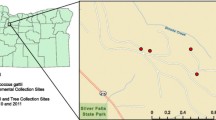Abstract
Human and animal infections of the fungus Cryptococcus gattii have been recognized in Oregon since 2006. Transmission is primarily via airborne environmental spores and now thought to be locally acquired due to infection in non-migratory animals and humans with no travel history. Previous published efforts to detect C. gattii from tree swabs and soil samples in Oregon have been unsuccessful. This study was conducted to determine the presence of C. gattii in selected urban parks of Oregon cities within the Willamette Valley where both human and animal cases of C. gattii have been diagnosed. Urban parks were sampled due to spatial and temporal overlap of humans, companion animals and wildlife. Two of 64 parks had positive samples for C. gattii. One park had a positive tree and the other park, 60 miles away, had positive bark mulch samples from a walkway. Genotypic subtypes identified included C. gattii VGIIa and VGIIc, both considered highly virulent in murine host models.

Similar content being viewed by others
References
Sorrell TC, Chen SC, Ruma P, Meyer W, Pfeiffer TJ, et al. Concordance of clinical and environmental isolates of Cryptococcus neoformans var. gattii by random amplification of polymorphic DNA analysis and PCR fingerprinting. J Clin Microbiol. 1996;34:1253–60.
Campbell LT, Currie BJ, Krockenberger M, Malik R, Meyer W, Heitman J, et al. Clonality and recombination in genetically differentiated subgroups of Cryptococcus gattii. Eukaryot Cell. 2005;4:1403–9.
Stephen C, Lester S, Black W, Fyfe M, Raverty S. Multispecies outbreak of cryptococcosis on southern Vancouver Island, British Columbia. Can Vet J. 2002;43:792–4.
MacDougall L, Kidd SE, Galanis E, Mak S, Leslie MJ, Cieslak PR, et al. Spread of Cryptococcus gattii in British Columbia, Canada, and detection in the Pacific Northwest, USA. Emerg Infect Dis. 2007;13:42–50.
Upton A, Fraser JA, Kidd SE, Bretz C, Bartlett KH, Heitman J, et al. First contemporary case of human infection with Cryptococcus gattii in Puget Sound: evidence for spread of the Vancouver Island outbreak. 2007. J Clin Microbiol. 2007;45:3086–8.
Byrnes EJ III, Bildfell RJ, Frank SA, Mitchell TG, Marr KA, Heitman J. Molecular evidence that the range of the Vancouver Island outbreak of Cryptococcus gattii infection has expanded into the Pacific Northwest in the United States. J Infect Dis. 2009;199:1081–6.
Datta K, Bartlett KH, Baer R, Byrnes E, Galanis E, Heitman J, et al. Spread of Cryptococcus gattii into Pacific Northwest region of the United States. Emerg Infect Dis. 2009;15:1185–91.
Harris JR, Lockhart SR, DeBess E, Marsden-Haug N, Wohrle R, Free C, et al. Clinical aspects of infection due to the emerging pathogen Cryptococcus gattii – United States. Clin Infect Dis. 2011;53:1188–95.
Kidd SE, Bach PJ, Hingston AO, Mak S, Chow Y, MacDougall L, et al. Cryptococcus gattii dispersal mechanisms, British Columbia, Canada. Emerg Infect Dis. 2007;13:51–7.
Mak S, Klinkenberg B, Bartlett KH, Fyfe M. Ecological Niche Modeling of Cryptococcus gattii in British Columbia, Canada. Environ Health Perspect. 2010;118:653–8.
Kidd SE, Chow Y, Mak S, Bach PJ, Chen H, Hingston AO, et al. Characterization of Environmental Sources of the Human and Animal Pathogen Cryptococcus gattii in British Columbia, Canada, and the Pacific Northwest of the United States. Appl Environ Microbiol. 2007;73:1433–43.
Staib F, Seibold M, Antweiler E, Fröhlich B, Weber S, Blisse A. The brown colour effect (BCE) of Cryptococcus neoformans in the diagnosis, control and epidemiology of C. neoformans infections in AIDS patients. Zentralbl Bakteriol Mikrobiol Hyg A. 1987;266:167–77.
Kwon-Chung KJ, Polacheck I, Bennett JE. Improved diagnostic medium for separation of Cryptococcus neoformans var. neoformans (serotypes A and D) and Cryptococcus neoformans var. gattii (serotypes B and C). J Clin Microbiol. 1982;15:535–7.
Iqbal N, DeBess EE, Wohrle R, Sun B, Nett RJ, Ahlquis AM, et al. For the Cryptococcus gattii Public Health Working Group. Correlation of genotype and in vitro susceptibilities of Cryptococcus gattii from the Pacific Northwest of the United States. J Clin Microbiol. 2010;48:539–44.
Meyer W, Aanensen DM, Boekhout T, Cogliati M, Diaz MR, Esposto MC, et al. Consensus multi-locus sequence typing scheme for Cryptococcus neoformans and Cryptococcus gattii. Med Mycol. 2009;47:561–70.
Fraser JA, Giles SS, Wenink EC, Geunes-Boyer SG, Wright JR, Diezmann S, et al. Same-sex mating and the origin of the Vancouver Island Cryptococcus gattii outbreak. Nature. 2005;437:1360–4.
Springer DJ, Chaturvedi V. Projecting global occurrence of Cryptococcus gattii. Emerg Infect Dis. 2010;16:114–20.
Bartlett KH, Kidd SE, Kronstad JW. The emergence of Cryptococcus gattii in British Columbia and the Pacific Northwest. Curr Infect Dis Rep. 2008;10:58–65.
Byrnes EJ III, Li W, Lewit Y, Ma H, Voelz K, Ren P, et al. Emergence and pathogenicity of highly virulent Cryptococcus gattii genotypes in the northwest United States. PLoS Pathog. 2010;6:e1000850.
Acknowledgments
We thank Robert Dyk, Brian Thomas, Trevor Lock, Andrea Mortenson, and Dr. Sara Walker for help with environmental sampling, plus Naureen Iqbal for help with MLST typing. In addition, we thank Darren Bruning and Dr. John Huntley for project design suggestions, Al Shay for tree species identification, Andrew Fox for cartography services, and USDA, APHIS, VS for financial support of the project.
Author information
Authors and Affiliations
Corresponding author
Additional information
The findings and conclusions of this article are those of the authors and do not necessarily represent the views of the Centers for Disease Control and Prevention.
Rights and permissions
About this article
Cite this article
Mortenson, J.A., Bartlett, K.H., Wilson, R.W. et al. Detection of Cryptococcus gattii in Selected Urban Parks of the Willamette Valley, Oregon. Mycopathologia 175, 351–355 (2013). https://doi.org/10.1007/s11046-013-9614-7
Received:
Accepted:
Published:
Issue Date:
DOI: https://doi.org/10.1007/s11046-013-9614-7




